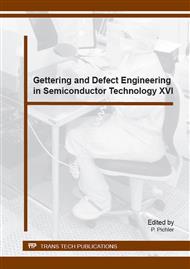p.163
p.169
p.175
p.184
p.190
p.196
p.205
p.211
p.218
Determination of the Free Gibbs Energy of Plate-Like Precipitates of Hydrogen Molecules and Silicon Vacancies Formed after H+ Ion Implantation into Silicon and Annealing
Abstract:
Hydrogen implantation at room temperature into monocrystalline silicon leads to the formation of complex defects and also to the appearance of in-plane compressive stress. During annealing hydrogen atoms and vacancies co-precipitate into platelets lying on two types of habit planes. These platelets play a decisive role in the fracture of the material that can occur during further annealing and which is used for the manufacture of SOI wafers. Thus, their stress assisted nucleation mechanism has to be well understood. Here, we develop a formalism based on the Volmer’s model which allows calculating the variation of the free Gibbs energy of the system following the nucleation of a platelet. In an unstressed crystal, this energy only relies on the habit plane of the platelet. When the system is under stress, this energy also depends on a term coupling this stress and the strain field generated by the platelet. Because those energies control the nucleation rate of the platelets variants, we could calibrate our model using the transmission electron microscopy observations of the platelets occurrences as a function of depth and, thus, as a function of the magnitude of the intrinsic stress and the angles between the stress direction and Burgers vectors of the considered platelets. These experimental distributions allowed us adjusting the parameters describing the Gibbs free energy of platelets.
Info:
Periodical:
Pages:
190-195
Citation:
Online since:
October 2015
Authors:
Keywords:
Price:
Сopyright:
© 2016 Trans Tech Publications Ltd. All Rights Reserved
Share:
Citation:


